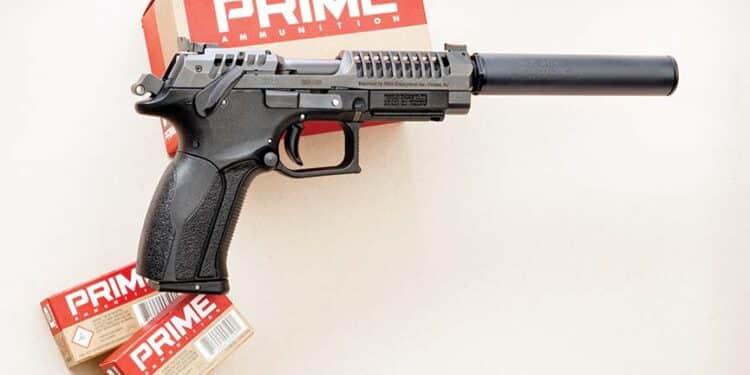Story & Photography by Oleg Volk
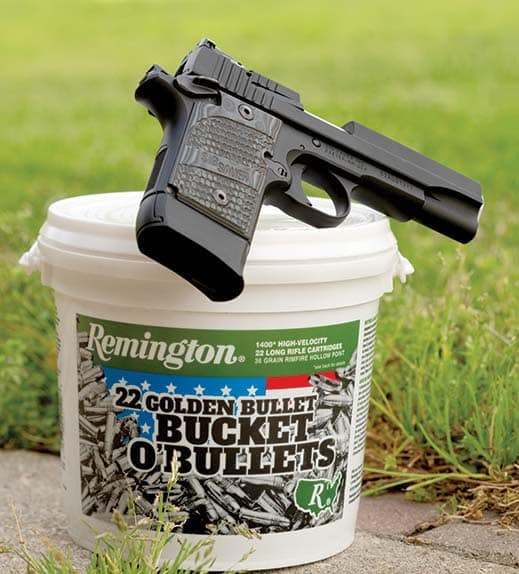
Subcaliber conversion kits predate self-contained cartridges. From the 1830s, some old muskets were converted with barrel inserts to project a small pellet with the energy of a percussion cap. Small bore inserts for pellets driven by blanks were also used with centerfire rifles from the 1870s on and dedicated rimfire clones of Army rifles from the early 1900s. The famous .455 Webley Mk V revolver of 1913 has an optional rimfire kit consisting of a rifled barrel insert and a cylinder with smaller .22 chambers. That was probably the first mass-produced conversion kit for training. During WWII, Colt Ace conversion kits permitted cheaper and less noisy practice with the Army M1911A1, a conversion that proved useful despite the originally spotty reliability.
Rimfire conversions, for a time, became popular in Europe as parts of multicaliber sets. The HK4 pistol, for example, came with barrels, springs and magazines supporting .22LR, .25ACP, .32ACP and .380ACP. The Beretta 8X series, on the other hand, featured standalone pistols of the same general design to cover the same range of calibers. The difference in the approach likely stemmed from the variations in national legal restrictions. In the U.S., Smith & Wesson (S&W) and Ruger offered rimfire counterparts to their popular service and concealed carry models. The stronger mainspring required for rimfire was one reason for making whole new guns instead of conversion kits, convenience is another. Finally, sights set for centerfire shooting seldom matched the point of impact with rimfire.
The story of modern subcaliber training in the U.S. can be recounted from the Ciener and Advantage Arms conversion kits for GLOCK pistols. Especially in times of ammunition shortages, the ability to stretch the training budget and the centerfire ammunition reserves on hand has been popular—as important, is the option to teach the basics of handling firearms and marksmanship without putting off new shooters with heavy recoil and loud blasts. Similar conversion kits have since become available for the M1911, Beretta M9 and several SIG SAUER models. At the same time, Walther, Chiappa and Umarex introduced visual clones of several common service pistols. Less true to the original manual of arms or feel, they nonetheless provided a reasonably familiar form factor for training and recreation. Finally, companies like Grand Power put out an entire XTRIM line of rimfire handguns designed with the form factor common to their defense line. Some of them are optimized for target shooting—the model with a 10-inch barrel comes to mind—while others mirror the defense or sports models in all but caliber.
Training Points
How good are these guns for actual training? They offer identical forms, so all practice with drawing to a rapid first shot, aimed or pointed, is authentic. The trigger pull is likewise the same, making trigger control practice consistent with the real thing. Reloading is quite similar; malfunction clearing is similar in some guns, dissimilar in others. Marksmanship depends on the degree of precision required. Obviously, the rimfire bullet trajectory differs from 9mm or .45ACP, but the differences are minute inside of 10m to 15m.
As practice guns for silhouette practice on small targets at 25m, .22s are not all that useful past the initial platform familiarization. In speed shooting for defense, the minor trajectory variations are insignificant compared to the minor sight alignment errors consciously committed in pursuit of speed. Gross errors like botched trigger control remain obvious. That’s especially vital for users of lightweight carry guns with heavy triggers, such as micro .380s and various Airweight snubbie revolvers. A training session of a hundred .357 Mag shots would cause hand damage, while a hundred .22s would just help master the long, heavy trigger pull without any pain.
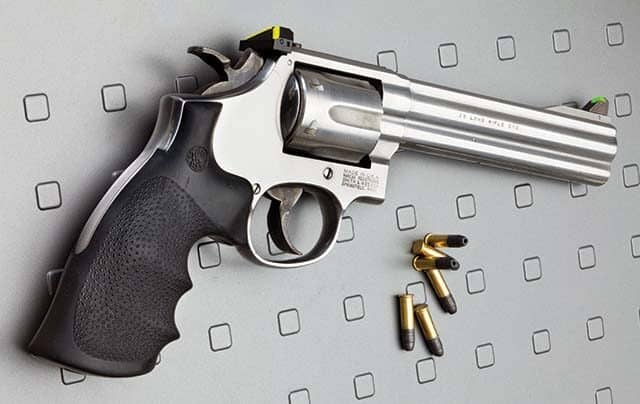
Obviously, one doesn’t learn recoil control from shooting the low-powered rounds; that is a skill facet requiring centerfire ammunition. The reduction in felt recoil and muzzle rise leave room for full caliber training, but the more comfortable shooting experience makes it easier to identify training issues. The actions of the novice shooter aren’t masked by the violent misalignment of a firearm immediately after each shot.
When introducing new people to handgun shooting, I typically start them with a sound-suppressed M1911 clone, a GSG 1911-22 heavily improved with CW Accessories (CWA) parts for accuracy and reliability. The light weight of the aluminum suppressor doesn’t affect the balance much, while the minimal sound signature and recoil permit a more comfortable learning experience. For revolvers, a S&W Model 617 loaded with Aguila® Colibri CB caps provides an ear-safe experience comparable with very low-power air pistols while matching the S&W Model 686 carry gun handling. At longer distances, subsonic .22LR works well. Unlike air guns, rimfire handguns have the same exact manual of arms as the centerfire weapons.
My experience has been with the following: an M1911 with an Iver Johnson Arms kit; a GSG1911-22 standalone; a Grand Power X-CALIBUR with an XTRIM standalone; a S&W M&P 9 with an M&P 22 standalone; a KelTec PF9 with a Twisted Industries kit; a GLOCK 17 with an Advantage Arms kit; a S&W Model 686 with a S&W Model 617; and a SIG SAUER P938 with 938-22 conversion slide. All of these have serious applications, and everyone has something to recommend over the others.
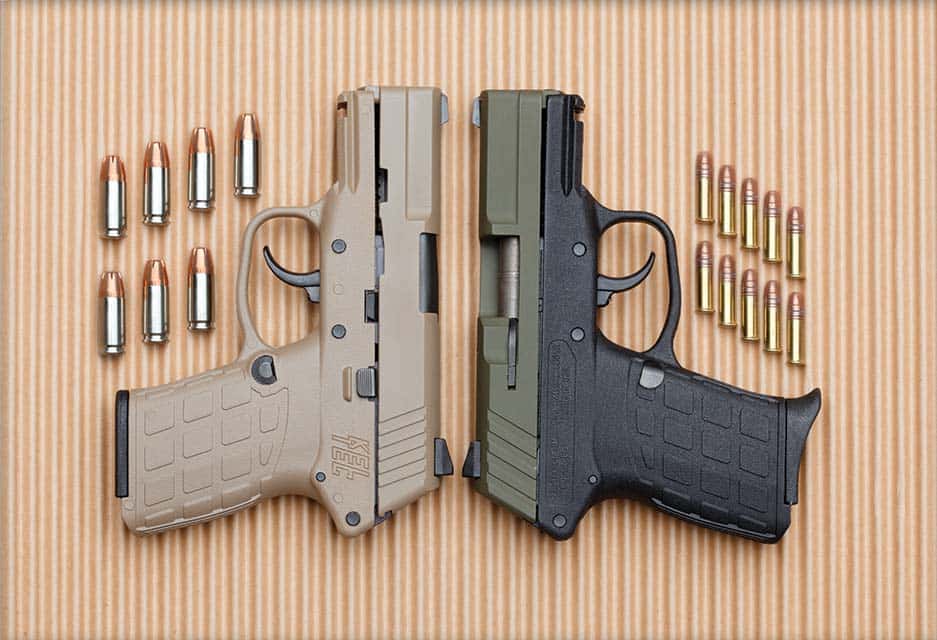
The revolvers are not ideal rimfire platforms for new shooters due to the heavy trigger pull required for the reliable detonation of .22LR primed rims. The S&W Model 617 (the large-frame rimfire) and the S&W Model 17 (the medium-frame rimfire) are also fractionally heavier than the .357 Mag and .38 Special counterparts thanks to the smaller bores and chambers inside the same-size barrels. For the same reason, these are very good for training advanced shooters: A person who learns to use the extra-heavy triggers will be able to run better centerfire triggers with ease. For new shooters, single-action mode works well—it also greatly reduces the required reach to the front of the trigger, an important consideration for learners with small hands.
Grand Power XTRIM
The XTRIM rimfire pistol from Grand Power mimics the carry guns exactly, down the shape of the magazines. The magazines are all polymer, hold 10 rounds and load with ease, thanks to the assist tab on the follower. The accuracy is excellent, the sights and all of the controls match X-CALIBUR exactly. The sole differences are the reduced blast and recoil. The XTRIM fits the same holsters, though it uses a slightly shorter slide. The extended safety lever makes a good thumb rest, habituating new shooters to the right-hand position. As with all rimfire pistols using a conventional enveloping slide, it’s possible to retard the relatively weak slide motion too much with the thumbs, a concern that doesn’t exist with the more energetic centerfire ammo. Designed for supersonic ammunition, the XTRIM also works with subsonic ammo using additional backpressure from suppressors or brakes. I prefer to use a linear compensator to channel the blast noise downrange.
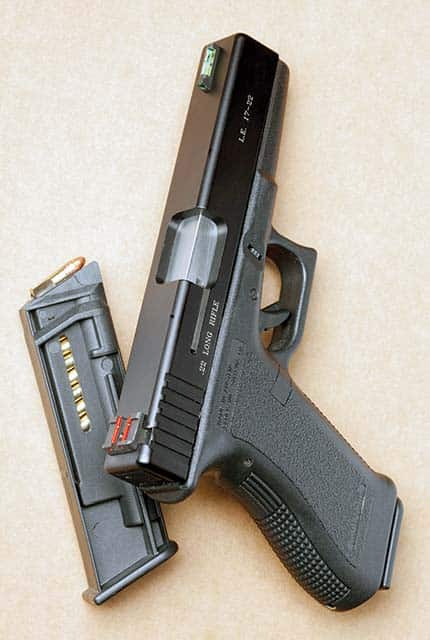
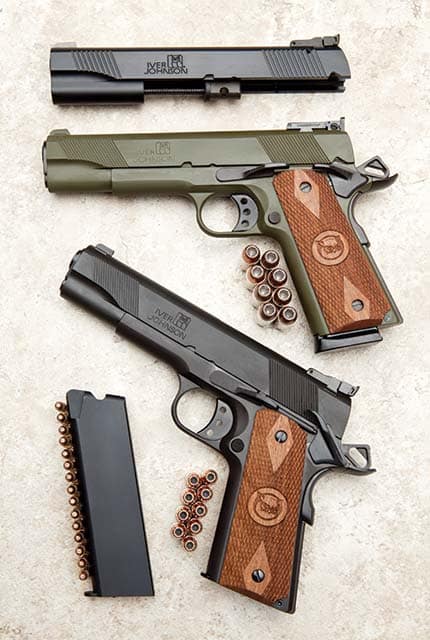
GLOCK 17
The Advantage Arms GLOCK 17 kit dates back to around 2000, with successively improved versions introduced since. Like most conversion kits, it uses a lightweight aluminum slide that’s dimensionally identical to the centerfire part. One caveat with safe-action handguns: Lightened triggers can cause light strikes with rimfire ammunition. On stock GLOCK frames, it’s extremely reliable and very accurate.
KelTec PF9
The same is true of the KelTec PF9™ conversions by Twisted Industries (TI). Instead of molded plastic, TI uses milled aluminum blocks to make extremely robust magazines for the kit. Accuracy is better than with the 9mm, and the relatively light weight—3/4 pound loaded with 10+1 instead of 1.1 pound with 7+1—makes it a viable kit gun for nature hikes. With the PF9 being a relatively difficult pistol to master due to the long 7-pound trigger, rimfire practice can aid in gaining competency without breaking the bank. Recoil that limits comfortable range time with lightweight pistols is also a non-issue with the conversion kit.
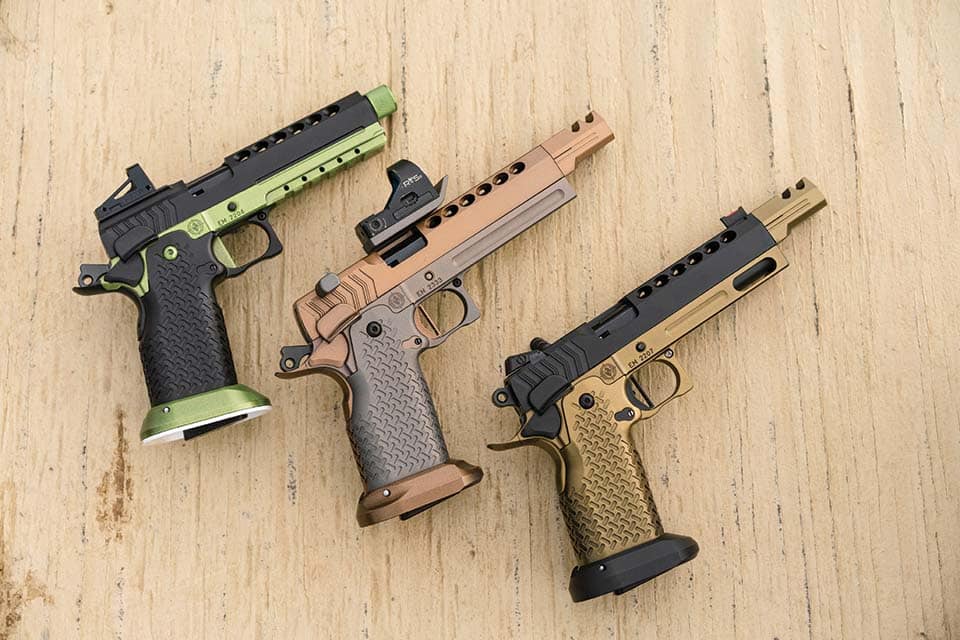
Smith & Wesson
The M&P 22 is a clone of the M&P 9 in look, feel and controls but not in the internals. Designed similarly to the Walther P22, the M&P 22 is a more durable implementation of the concept. Feeding from 12-shot magazines, it’s a competent target pistol in itself. While the M&P 9’s recoil is mild, the lower cost of ammunition pays for the rimfire kit quickly. The pistol suppresses well and runs reliably with a wide range of loads.
SIG SAUER
The SIG SAUER P938-22 slide is 1 inch longer than the 9mm version. The magazine comes with an extended plastic floorplate to extend capacity to 10 rounds instead of the six or seven in the centerfire variant. With these changes, it isn’t an exact clone of the main weapon, but it is a very comfortable and accurate trainer. Its longer sight radius makes it a little easier to aim but limits holster compatibility. Everything else on the 938-22 matches the regular P938.
M1911
M1911 conversion kits have a mixed reputation. The Iver Johnson kit actually works well. Like the PF9 kit, it comes with machined aluminum magazines. Cheaper and lighter plastic magazines made by ProMag™ work equally well or better. The conversion delivers impressive accuracy, making the frame with a kit a target gun in itself. All functionality of the regular M1911 is preserved. Compared to that, the GSG standalone 1911-22 has a less refined trigger and a magazine disconnector—not quite the same manual of arms as the real thing. After the plastic recoil spring guide snapped in half, I replaced it and several other parts (extractor, ejector, barrel, bushing, springs and sights) with CWA parts. The upgraded pistol is significantly more accurate, permitting reliable hits on an 8-inch plate from 100 yards. Actual CWA 2011-22 pistols do not suffer from the magazine disconnector. Unlike STI 2011 rimfire adapters, CWA uses a single-stack GSG magazine, so they would not fit centerfire mag carriers. On the plus side, those magazines are much less expensive and easier to load.
Consider This
Pistol rimfire conversion kits fall short with red dot optics. The energy available from the .22LR recoil isn’t enough to move a red dot sight back and forth, so the conversion kits normally have no provision for anything other than iron sights. The CWA 2011-22 is the exception to that, having the option of a frame-mounted red dot for an exact match of the centerfire race-gun configuration. For training towards greater competency with iron-sighted handguns and for recreational shooting, rimfire conversion kits and standalone clones of fighting pistols are well worth having.
| This article first appeared in Small Arms Review V24N7 (Aug/Sep 2020) |



